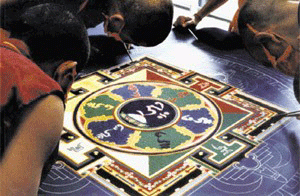
A world peace pledge in a beauty pageant may trigger cynical sniggers, but those with shaven heads and saffron robes specialise in its propagation – with none more qualified than the Dalai Lama.
In July the world’s most renowned monk turns 75. In celebration, six Tibetan monks are visiting SA this month on what is billed a World Peace and Compassion Tour.
They will create sand mandalas to highlight the work of His Holiness.
Aristotle believed every life form was drawn to what he called “autocompletion”. Carl Jung was fascinated by the process of “individuation”, in which human beings develop towards maturity and serenity.
Abraham Maslow called it “self-actualisation”. These impressive words can be put into a picture: the mandala.
At one point in his life, Jung created a mandala drawing every day. He believed mandalas exerted “a retroactive influence on the unconscious”.
He described them as symbols of “psychological growth, expressing the idea of a safe refuge, inner reconciliation and wholeness”.
In Tibet, the mandala has become a specialised art form and to the Buddhist monks it is more than a mesmerising picture. It’s an event.
The construction takes several days or weeks and the process is as important as the finished product.
To signify impermanence, the mandala is destroyed on the same day as its completion. The sand is brushed together and placed in a body of running water to spread the blessings.
It takes years of training to gain the knowledge required to produce these fleeting visions. The monks visiting our shores are masters of the art and hail from the remote Rizong monastery in Ladakh.
Overseeing the project is the abbot of Rizong, the Venerable Tsultim Stanba, 70. Three of the monks are masters of overtone chanting, the resonance of which is said to have a subtle healing influence.
The sand-painting process opens with an elaborate ceremony during which the monks consecrate the site and call forth the forces of goodness.
They chant, declare intention, do visualisations and recite mantras.
They then draw the geometric measurements of the mandala onto a wooden platform. The following days see the laying of the multicoloured sands.
The Tibetan word for mandala is khyil-khor which, roughly translated, means “centre of the universe in which a fully awakened being abides”. As an image, it can symbolise the mind of the Buddha.
The designs, however, are explicitly based on scriptural texts and tend to contain a resident deity housed at the centre of a square within a series of circles.
One of the outer circles often represents a ring of fire, symbolising the process of transformation which human beings have to pass through before entering the sacred territory within.
This square structure has four gates, each symbolising one of the “limitless contemplations” that comprise the foundation of Tibetan Buddhism itself: loving-kindness, compassion, joy and equanimity.
Occasionally there is a sexual image at the centre. Sexual imagery can be understood as a metaphor for enlightenment, with its qualities of satisfaction, bliss and unity.
Mandalas often house a wrathful deity, which represents the struggle involved in overcoming alienation.
They embody the inner afflictions that darken our thoughts and prohibit the Buddhist goal of awakening.
They are ultimately considered benevolent, fearful only to those who perceive them as alien forces.
Then there are the peaceful deities, with the Bodhisattva of compassion, Chenrezig, perhaps the most famous and the central figure for the mandalas being created in SA on this tour.
By their mere presence, mandalas remind us of the immanence of sanctity in the universe, and its potential in ourselves.
In the Buddhist context, their final purpose is to put an end to suffering, not only one’s own, but of all sentient beings. It suggests that even the seemingly impossible is worth doing.
In an age when the notion of world peace has become jaded, six monks will be hard at work to keep the ideal alive.
For programme details, contact: Durban: 031 701 4307; Joburg: 083 255 6089; Cape Town: 021 786 1544. Visit www.tibet.org.za
Source : http://www.timeslive.co.za




